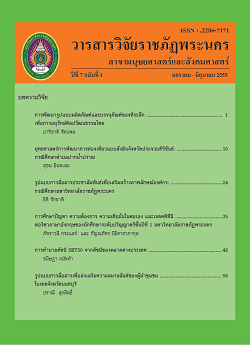ยุทธศาสตร์การพัฒนาการท่องเที่ยวแบบยั่งยืนจังหวัดประจวบคีรีขันธ์: กรณีศึกษาตำบลปากน้ำปราณ
Main Article Content
Abstract
การวิจัยครั้งนี้มีวัตถุประสงค์เพื่อ 1) ศึกษาบริบทการท่องเที่ยวของตำบลปากน้ำปราณ 2) ศึกษา พฤติกรรม ความพึงพอใจของนักท่องเที่ยวตำบลปากน้ำปราณ 3) สร้างและประเมินยุทธศาสตร์การพัฒนา การท่องเที่ยวแบบยั่งยืนจังหวัดประจวบคีรีขันธ์: กรณีศึกษตำบลปากน้ำปราณ โดยใช้ระเบียบวิธีวิจัยแบบ ผสมผสานเชิงคุณภาพและเชิงปริมาณ เก็บรวบรวมข้อมูลเชิงคุณภาพโดยการสัมภาษณ์แบบเจาะลึก การสนทนากลุ่มการวิ เคราะห์สภาพแวดล้อมภายในและภายนอก (SWOT Analysis) ใช้การวิจัยเชิงปฏิบัติการ แบบมีส่วนร่วมพร้อมด้วยเทคนิค AIC การเก็บข้อมูลด้วยแบบสอบถาม การตรวจสอบข้อมูลใช้วิธีการสามเส้า การวิเคราะห์ข้อมูลโดยการวิเคราะห์เนื้อหา การวิเคราะห์ข้อมูลทางสถิติใช้ค่าร้อยละและค่าเฉลี่ย
ผลการวิจัย พบว่า
1. ตำบลปากน้ำปราณ มีแหล่งท่องเที่ยวทางธรรมชาติ ที่มีความหลากหลายทางชีวภาพทางระบบนิเวศ มีกิจกรรมที่ส่งเสริมการท่องเที่ยว คือ การเดินศึกษาธรรมชาติ การปลูกป่าชายเลน การเข้าถึงแหล่ง ท่องเที่ยวได้สะดวก มีเส้นทางการท่องเที่ยวที่สามารถเชื่อมโยงไปยังแหล่งท่องเที่ยวใกล้เคียงได้
2. นักท่องเที่ยวส่วนใหญ่มีความพึงพอใจในการมาท่องเที่ยวตำบลปากน้ำปราณอยู่ในระดับปานกลาง ปัญหาที่พบจากการมาท่องเที่ยวของนักท่องเที่ยว คือ การกำจัดขยะ การระบายน้ำเสียลงสู่แม่น้ำปราณบุรี สถานที่จอดรถและห้องสุขาสาธารณะไม่เพียงพอ ไม่มีป้ายบอกทางที่ชัดเจน
3. ยุทธศาสตร์การพัฒนาการท่องเที่ยวได้วิสัยทัศน์คือ “พัฒนาการท่องเที่ยวเชิงนิเวศ เพิ่มมูลค่า ผลิตภัณฑ์ชุมชน ปลูกจิตสำนึกการอนุรักษ์ทรัพยากรธรรมชาติ (เพื่อพัฒนาการท่องเที่ยวแบบยั่งยืน)” มี 4 ประเด็นยุทธศาสตร์ ได้แก่ 1) พัฒนาแหล่งท่องเที่ยวและส่งเสริมกิจกรรมการท่องเที่ยวเชิงนิเวศ 2) ส่งเสริมและเพิ่มมูลค่าผลิตภัณฑ์ชุมชน 3) การบริหารจัดการการท่องเที่ยวแบบบูรณาการ และ 4) ส่งเสริม การมีส่วนร่วมทุกภาคส่วนเพื่อพัฒนาการท่องเที่ยวแบบยั่งยืน และ ผลการประเมินยุทธศาสตร์มีความ เหมาะสมระดับมาก สอดคล้องกับบริบทของท้องถิ่นและสามารถนำไปสู่การปฏิบัติได้
The Strategies of Sustainable Tourism Development in Phachupkhirikhan Province : The Case Study of Paknampran Sub-district
The objectives of this research were (1) to study tourism context of Paknampran Sub-district (2) to investigate tourist satisfaction, (3) to formulate and evaluate strategies for sustainable tourism development. Methodology used in this research incorporated qualitative and qualitative methods. As for the qualitative method, data were collected through in-depth interviews, focus group discussions, SWOT analysis, PAR with A-I-C technique. A questionnaire was delivered to collect data. Triangulation was performed to validate findings. In addition, content analysis was carried out. The statistics used for data analysis included frequency, percentage, and mean. The findings of this research were as follows:
1. Paknampran Sub-district has natural resources and rich biodiversity. Activities promoting tourism includes trekking along natural trails and planting mangrove forests. The tourist resources are easily accessible. It is located on routes linking to nearby tourist attractions.
2. Most tourists expressed satisfaction with trips to Paknampran Sub-district at a middle level. However, there are some problems such as waste disposal, waste water treatment, inadequacy of parking area, public toilets, as well as no clear signposts.
3. The strategies for tourism development consist of developing eco-tourism, increasing the values of community products, raising awareness of natural resource preservation for sustainable tourism development. In order to pursue these strategies, four plans have been devised, namely (1) developing tourist attractions and promoting eco-tourism activities, (2) promoting and increasing values of community products, (3) managing integrative tourism, and (4) inviting all sectors to involve in sustainable tourism. The evaluation of the strategies suggests that these strategies deems appropriate to the community context and practical.
Article Details
Each publish articles were copyright by Phranakorn Rajabhat University
Any contents which appeared in each articles in the journal were authors personal opinion. It did not relate to Phranakorn Rajabhat University and other instructors in the university. Each authors would take responsibility on their articles. If there are any mistake, the authors will take responsibility themselves


